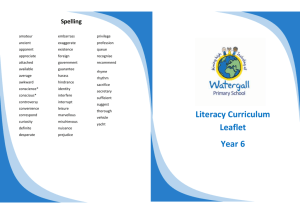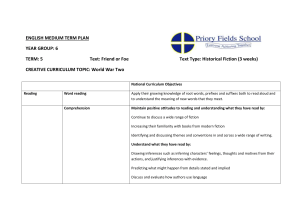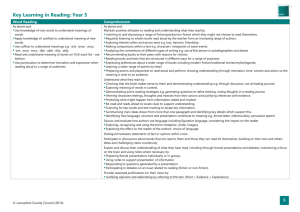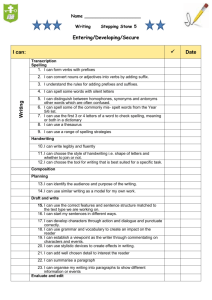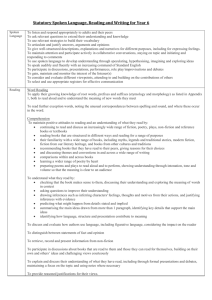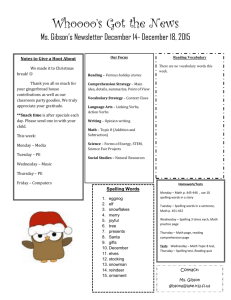Literacy expectations for Year 5
advertisement
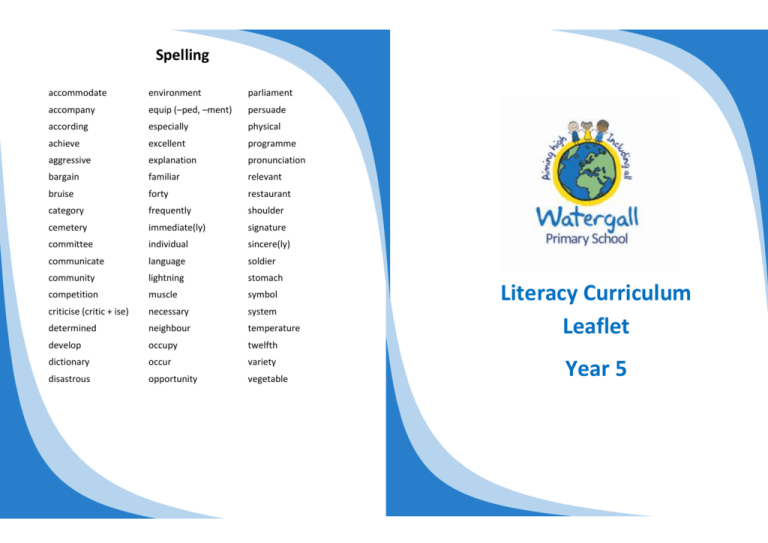
Spelling accommodate environment parliament accompany equip (–ped, –ment) persuade according especially physical achieve excellent programme aggressive explanation pronunciation bargain familiar relevant bruise forty restaurant category frequently shoulder cemetery immediate(ly) signature committee individual sincere(ly) communicate language soldier community lightning stomach competition muscle symbol criticise (critic + ise) necessary system determined neighbour temperature develop occupy twelfth dictionary occur variety disastrous opportunity vegetable Literacy Curriculum Leaflet Year 5 Year 1 Reading By the end of Year 5 children should be able to: Apply knowledge of root words,prefixes and suffixes to read aloud and understand the meaning of new words Read and discuss a wide range of fiction (including myths, legends and traditional stories, modern fiction, fiction from our literary heritage, and books from other cultures and traditions), poetry, plays, non-fiction and reference books Recommend books to peers, giving reasons for their choices Identify and discuss themes in a wide range of writing (e.g. loss, heroism, gratefulness, victimisation) Identify and discuss conventions in a wide range of writing (e.g. first and third person) Make comparisons within and across books (e.g. characters, viewpoints on events, moods, settings, themes) Check that the text makes sense, discussing their understanding, exploring the meaning of words in context and asking questions to improve understanding Draw inferences and justify them with evidence (e.g. inferring characters’ feelings, thoughts and motives from their actions) Predict what might happen from details stated and implied Summarise the main ideas from more than one paragraph, identifying key details to support this Identify how language, structure and presentation contribute to meaning Discuss and evaluate how authors use language, including figurative language, considering the impact on the reader Distinguish between fact and opinion Retrieve, record and present information from non-fiction Prepare poems and plays to read aloud and to perform, using intonation, tone and volume so that the meaning is clear to an audience Help at home by: Listening to your child read every night or supervising them if they want to read to themselves Talking to your child about what they have read— ask them about the plot, characters, key facts, predictions, themes and authors word choices Encourage them change their book regularly Taking your child to Bretton library so they can borrow books. Try reading non-fiction books, plays, comics, magazines, reference books and poetry together too Encouraging children to try out new authors to develop favourite authors or series of books and read lots of them e.g. Michael Morpurgo, David Walliams, Anthony Horowitz, David Almond, Phillip Pullman, J.K. Rowling Reading for real reasons e.g. recipes, instructions for playing games, newspapers, websites, emails, TV guide Writing By the end of Year 5 children should be able to: Create and develop plans for writing, noting and developing initial ideas, drawing on reading and research Use the styles of familiar authors to develop character and setting Use dialogue to convey character and advance the action in narrative Précis longer passages Use devices to build cohesion within a paragraph (e.g. then, after, this, that, firstly) Link ideas across paragraphs using adverbials of time, place, number or tense choice Use organisational and presentational features to guide the reader (e.g. headings, bullet points, underlining) Proof read work for consistent and correct use of tenses, subject and verb agreement when using singular and plural, spelling and punctuation errors Use passive verbs to change how information sounds Use the perfect form of verbs to show time and cause Use expanded noun phrases to make complicated information easier to understand Use modal verbs (might, should, will, must) or adverbs (perhaps, surely) to show possibilities Use relative pronouns for relative clauses (starting who, which, where, when, whose, that) Avoid ambiguity by using commas to separate clauses and phrases in sentences and hyphens (e.g. man-eating shark not man eating shark) Use brackets, commas or dashes for parenthesis Use semi-colons, colons and dashes correctly to separate clauses Use a colon to introduce a list and use bullet points consistently Spell words with silent letters Use knowledge of word structure in spelling Use the first three or four letters of a word to check spelling, meaning or both of these in a dictionary Use a thesaurus To write legibly, fluently and with speed Help at home by: Reading and telling lots of stories in English or in your home language Encouraging children to write for a range of purposes e.g. notes and messages, emails, letters, diaries, menus, stories, instructions Practising spelling Encouraging neat, legible handwriting whenever children are writing
